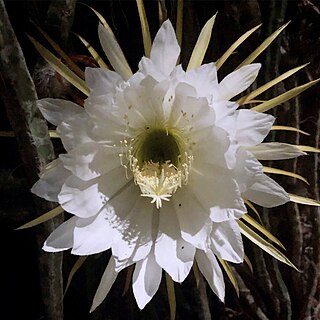
Night-blooming cereus is the common name referring to a large number of flowering ceroid cacti that bloom at night. The flowers are short lived, and some of these species, such as Selenicereus grandiflorus, bloom only once a year, for a single night. Other names for one or more cacti with this habit are princess of the night, Honolulu queen, Christ in the manger, dama de noche and queen of the night.

Epiphyllum is a genus of epiphytic plants in the cactus family (Cactaceae), native to Central America and South America. Common names for these species include climbing cacti, orchid cacti and leaf cacti, though the latter also refers to the genus Pereskia.

Selenicereus, sometimes known as moonlight cactus, is a genus of epiphytic, lithophytic, and terrestrial cacti, found in Mexico, Central America, the Caribbean and northern South America. The term night-blooming cereus is also sometimes used, but this is also used for many night-blooming cacti, including Epiphyllum and Peniocereus. In 2017, the genus Hylocereus was brought into synonymy with Selenicereus. A number of species of Selenicereus produce fruit that is eaten. The fruit, known as pitaya or pitahaya in Spanish or as dragon fruit, may be collected from the wild or the plants may be cultivated.

Weberocereus is genus of cacti. It produces a green and white flower and is found mainly in Costa Rica and Nicaragua.

Selenicereus undatus, the white-fleshed pitahaya, is a species of Cactaceae and is the most cultivated species in the genus. It is used both as an ornamental vine and as a fruit crop - the pitahaya or dragon fruit. The native origin of the species has never been resolved.

Disocactus ackermannii is an epiphytic cactus from tropical forests in the states of Veracruz and Oaxaca, Mexico. In cultivation, it has been confused with Disocactus × jenkinsonii, a hybrid between D. phyllanthoides and D. speciosus.

Disocactus crenatus, the crenate orchid cactus, is a species of cactus and one of the most important parents in creating the epiphyllum hybrids commonly cultivated throughout the world. It is cultivated for its large white flowers.
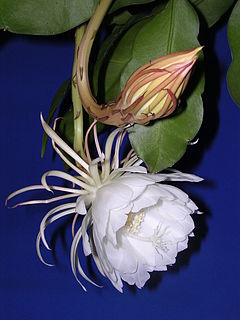
Epiphyllum oxypetalum, the Dutchman's pipe cactus, princess of the night or queen of the night, is a species of cactus. It rarely blooms and only at night, and its flowers wilt before dawn. Though it is sometimes referred to as a night-blooming cereus, it is not closely related to any of the species in the tribe Cereeae, such as Selenicereus, that are more commonly known as nightblooming cereus. All Cereus species bloom at night and are terrestrial plants; Epiphyllum species are usually epiphytic.

Disocactus phyllanthoides, the nopalxochitl or German empress, is a species of flowering plant in the cactus family Cactaceae. It is commonly grown as an ornamental houseplant. It is one of the three major species involved in creating the widely grown epiphyllum hybrids or "epis". The others are Disocactus speciosus and Disocactus crenatus.
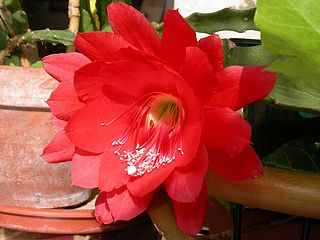
Disocactus × jenkinsonii is a hybrid between Disocactus phyllanthoides and Disocactus speciosus. It is perhaps the most commonly grown orchid cactus and seems to survive and flower under most conditions. It has a very complex taxonomic history and has been mistaken for Disocactus ackermannii for a long time.

Selenicereus spinulosus is a cactus species native to eastern Mexico and, possibly, the lower Rio Grande Valley of Texas in the United States. Common names include vine-like moonlight cactus and spiny moon cereus. Its specific name, spinulosus, means "with small spines" in Latin.

Disocactus anguliger, commonly known as the fishbone cactus or zig zag cactus, is a cactus species native to Mexico. The species is commonly grown as an ornamental for its fragrant flowers in the fall.
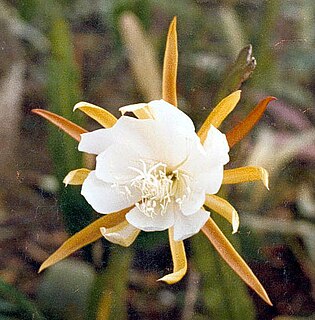
Epiphyllum laui is a cactus species native to Mexico and grown as an ornamental.
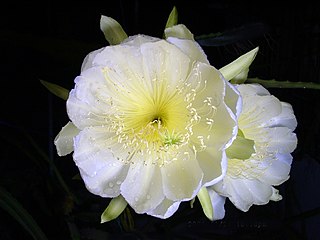
Selenicereus megalanthus, synonym Hylocereus megalanthus, is a cactus species in the genus Selenicereus that is native to northern South America, where it is known, along with its fruit, by the name of pitahaya. The species is grown commercially for its yellow fruit, but is also an impressive ornamental climbing vine with perhaps the largest flowers of all cacti.

Aporocactus martianus is a species of cactus found in Oaxaca, Mexico.

Epiphyllum pumilum is a cactus species native to Mexico and Guatemala. The species is commonly grown as an ornamental for its beautiful, fragrant flowers in the summer.
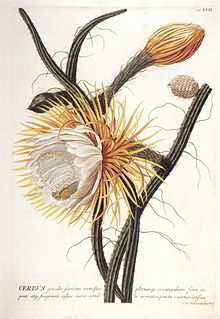
Selenicereus grandiflorus is a cactus species originating from the Antilles, Mexico and Central America. The species is commonly referred to as queen of the night, night-blooming cereus, large-flowered cactus, sweet-scented cactus or vanilla cactus. The true species is extremely rare in cultivation. Most of the plants under this name belong to other species or hybrids. It is often confused with the genus Epiphyllum.

The Hylocereeae are a tribe of cacti. Most are found in the tropical forests of Central and northern South America, and are climbers or epiphytes, unlike most cacti. The tribe includes between six and eight genera in different circumscriptions. The plants known as "epiphyllum hybrids" or "epiphyllums", widely grown for their flowers, are hybrids of species within this tribe, particularly Disocactus, Pseudorhipsalis and Selenicereus, less often Epiphyllum, in spite of the common name.

Epiphyllum hybrids, epiphyllums, epicacti, or just epis, also known as orchid cacti, which are widely grown for their flowers, are artificial hybrids of species within the group of cacti placed in the tribe Hylocereeae. In spite of the common name, epiphyllum hybrids mainly involve Disocactus species instead of Epiphyllum species, though Selenicereus grandiflorus and some unconfirmed Epiphyllum species were reportedly used for hybridization. Other sources include Pseudorhipsalis in the parentage of the group.
Deamia chontalensis is a species of flowering plant in the family Cactaceae, native to southwestern Mexico and Guatemala. It has sprawling or pendent branched stems and fragrant white flowers.






















